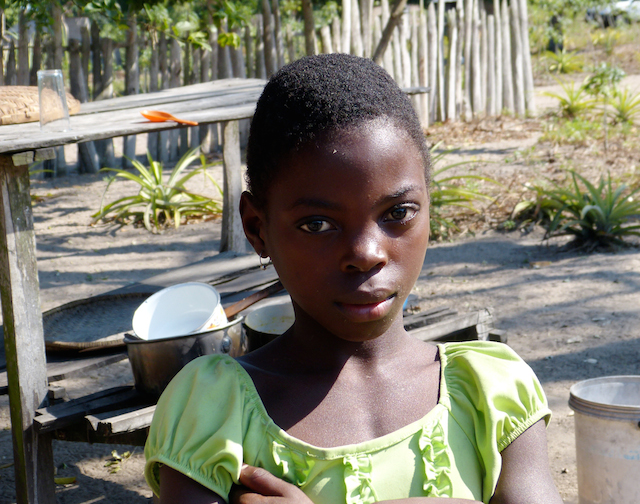Mozambique Tackles its Twin Burden of Cervical Cancer and HIV

MAPUTO, Oct 31 (IPS) - The woman on bed 27 in Maputo Central Hospital's oncology ward has no idea how lucky she is. In January, when abdominal pains wracked her, a pharmacist suggested pain killers. For months, "the pain would go and return," she told IPS.
In April she went to the local clinic in Matola, 15kms from Mozambique's capital, Maputo. Its nurses had just been trained and equipped to detect cervical cancer. An invasive growth was found and the patient referred to Maputo Central Hospital (HCM, in Portuguese). Chemotherapy started in June. When IPS met her, she had just finished the third month of chemo. Doctors are optimistic.
What saved her was something new in Mozambique - routine screening for cervical cancer done by nurses in basic health facilities.
"Women seek help when they feel pain, and pain means cancer at advanced stage," says nurse Ana Mafalda Chissano. "But if they go to the gynaecologist and get a pap smear, that takes months, plus time and bus fare. By then, it's too late."
Mozambique has Africa's highest cervical cancer cumulative risk and mortality — seven out of 100 newborn girls will develop this cancer and five will die from it — and ranks second in incidence after Malawi, according to the Africa coalition on maternal, newborn and child health.
Every year, 5,600 Mozambican women are diagnosed with cervical cancer. Of these, 4,000 die – 11 every day. There is no palliative radio therapy; it is a painful death.
These are the recorded deaths only. Just over half of Mozambicans have access to health care, so many die at home undiagnosed.
HIV a risk factor
High HIV prevalence – one in 10 Mozambicans has the virus - compounds the problem. HIV positive women have higher risk of developing this cancer, and at a lethal speed.
"The weaker the immune system is, the faster cervical cancer grows," explains Dr. Amir Modan, with the United Nations Population Fund in Maputo.
Chissano works with Doctors without Borders (MSF) at Alto Maé, a government clinic in Maputo, where HIV prevalence is 20 percent. Among HIV positive women screened here, one-third show pre-cancerous lesions or cervical cancer, Chissano told IPS.
Cervical cancer is the most frequent cancer among Mozambican women aged 15-44, says Modan.
Health authorities are tackling the problem through information campaigns and by integrating routine screening in family planning services. They hope to reach all districts by 2017.
Nearly 1,000 nurses have been trained, says Dr Aventina Cardoso, cervical cancer adviser at health group Jhpiego in Mozambique. "But demand and needs outpace human resources."
Jhpiego data shows that ten percent of women screened show pre-cancerous lesions and five percent have cervical cancer.
After treatment with cryosurgery (freezing), a woman should abstain from sex during 30 days. This can be tricky, says Janet Gibunda, an MSF nurse at Alto Mae clinic, because many women must inform the husband about the sex ban before having the procedure.
"But they return, we don't lose them," she says. "I think the shocking photos of advanced cancer we show them make them come back."
Early sex and witchcraft
Cervical cancer is caused by the human papilloma virus (HPV), transmitted mostly through sex. It is a common virus; many people carry it but it remains dormant. Of the 40 types of HPV, some go away on their own, some cause genital warts, and some cause cancer.
Risk factors for cervical cancer include HIV, early first sex, sexually transmitted infections, multiple sexual partners, long-term use of oral contraceptives, smoking tobacco and family history of cancer.
Another risk factor is low condom use. Less than a quarter of people use condoms in risky sex, says Modan, heightening exposure to both HPV and HIV. HPV infection doubles the risk of acquiring HIV, while HIV hastens progression of cervical cancer.
High fertility at early age and a high number of live births increase the risk. This is bad news for Mozambique's child brides. Four out of ten girls are mothers by age 19 and on average a woman bears more than five children, says Modan.
"Girls start having sex very early; by age 25, they may have 12 years of sex," says Cardoso.
According to the 2011 demographic health survey, one-third of women had first sex before age 15.
The patient on bed 27, now aged 52, married at age 15 and bore seven children.
Layne Heller is a Christian volunteer at the HCM oncology ward. This is her fifth year giving emotional support to patients during the long and lonely months of chemotherapy, which are especially hard for women from the provinces.
"They are so scared," says Heller. "Back home, the perception is that women come to HCM to die. They are terrified."
To some extent, it was true. Women arrived in terminal stages of cancer and died. But now, with early detection and better treatment, more women survive.
A study conducted by Cardoso in Zambezia province in 2010 found that half of women interviewed associated cervical cancer with promiscuity and 42 percent with witchcraft.
"Cervical cancer was called ‘the neighbour's disease' because people believed a neighbour had placed a curse on the woman," explains Cardoso. "But that is changing thanks to the information campaign."
Launched in 2013 and led by the former First Lady, Maria da Luz Guebuza, the campaign saturated the media and all kinds of events, from mother's day to fashion shows.
A key issue, says Cardoso, is reinforcing the concept of prevention in health care.
"Prevention is not part of our culture," she says. "We only go to hospital when we are sick. This is slowly changing as people realise how important it is to prevent."
© Inter Press Service (2014) — All Rights ReservedOriginal source: Inter Press Service
 Global Issues
Global Issues